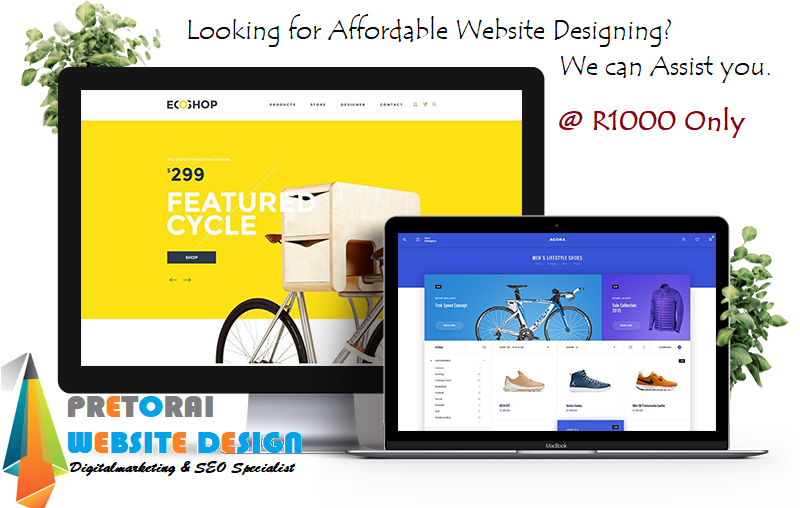Elevate Your Brand with Expert Web Design Pretoria Solutions
A Comprehensive Guide to Responsive Internet Style Strategies
Responsive website design has become a crucial component in the growth of electronic platforms, permitting a seamless individual experience across a multitude of devices. This guide will certainly explore important methods such as fluid formats, media queries, and picture optimization that add to effective responsive layout. By understanding these concepts, developers can develop sites that not just adjust visually but additionally improve customer engagement. Nevertheless, the landscape of web style is regularly evolving, increasing inquiries regarding the future of responsiveness and the methods that will define it.
Recognizing Responsive Website Design
Responsive website design (RWD) is a technique that ensures a web site's design and material adjust effortlessly across a selection of gadgets and screen dimensions (Web Design Pretoria). This layout approach is necessary in today's electronic landscape, where individuals gain access to sites from smartphones, tablets, laptops, and computer. RWD enhances customer experience by allowing a website to keep performance and appearances, no matter the gadget being utilized
A key component of RWD includes liquid grids that utilize relative devices, such as portions, instead of taken care of systems, to define format aspects. This flexibility makes it possible for photos, text, and various other parts to resize proportionally, providing an ideal viewing experience. Furthermore, media questions are utilized to apply various designs based on tool qualities like display width and orientation. This strategy ensures that the site's design is tailored to the particular needs of individuals, improving functionality.
Additionally, RWD adds favorably to look engine optimization (SEARCH ENGINE OPTIMIZATION) by advertising a single, constant link for a website, which streamlines web link sharing and indexing. As mobile phone usage proceeds to climb, understanding and applying receptive web layout is vital for services intending to get to a broader audience and enhance total internet efficiency.
Key Principles of Responsive Style
To create an effective responsive design, numerous key principles have to be thought about. This indicates designing for the tiniest screens initially and considerably improving the layout for larger gadgets.
Second, flexible grids and designs are essential. Making use of a grid system that adjusts to different screen sizes enables for a harmonious circulation of web content, ensuring readability and functionality across tools. This versatility is matched by the use loved one units, such as ems or percents, as opposed to fixed pixels.

Finally, prioritizing material hierarchy is essential. Clear and logical organization of content improves individual experience, leading site visitors through the website effortlessly, no matter of the tool utilized. Web Design Pretoria. By adhering to these principles, developers can create internet sites that are not just visually enticing yet likewise functional and user-centered across all gadgets
Techniques for Liquid Layouts
Fluid designs are crucial for developing adaptive internet experiences that flawlessly get used to various display sizes. By utilizing percentage-based widths rather of dealt with pixel values, developers can guarantee that elements on a web page resize proportionally, keeping visual harmony across tools. This strategy advertises flexibility, permitting content to stream and adjust as the viewport modifications.
One efficient technique for achieving fluid designs is to utilize CSS Flexbox or Grid systems. These CSS modules allow designers to create responsive frameworks that can quickly resize and rearrange based upon the readily available space. Flexbox masters one-dimensional designs, while Grid is excellent for two-dimensional setups, giving better control over positioning and placement.
One more technique involves using media queries to define breakpoints where changes are required - Web Design Pretoria. By specifying different designs for various display dimensions, designers can modify design properties dynamically, making certain optimum usability and aesthetic allure
Furthermore, including loved one units like ems or rapid eye movements for font sizes and spacing can even more enhance fluidness, as these devices range based upon user setups or parent aspects. Together, these strategies facilitate the growth of liquid layouts that advertise an engaging customer experience across varied gadgets.
Maximizing Photos for All Devices
Photos play an important role in internet layout, and maximizing them for numerous devices is vital for improving efficiency and user experience. To attain this, designers must utilize receptive picture strategies that make certain photos display correctly across various display dimensions and resolutions.
One efficient technique is using the HTML" element, which allows for specifying multiple picture sources based upon the screen problems. By utilizing 'srcset' characteristics, programmers can offer various photo resolutions, allowing the browser to choose one of the most appropriate one for the customer's device.
Additionally, executing appropriate data formats is crucial. Styles such as JPEG, PNG, and WebP each offer distinct purposes and can dramatically impact filling times. WebP, as an example, supplies exceptional compression, causing smaller file sizes without giving up top quality.
One more essential aspect is picture compression. Devices like TinyPNG or ImageOptim can lower file dimensions, boosting filling rate while preserving visual integrity. Making use of CSS for history photos can simplify filling as they can be adjusted a lot more fluidly across devices.
Eventually, enhancing pictures not only enhances website efficiency yet additionally adds to much better user interaction and retention, making it a fundamental practice in receptive website design.
Examining and Keeping Responsiveness
Ensuring a smooth individual experience across various devices calls for attentive testing and maintenance of responsiveness. The web link initial step in this procedure is to use a mix of manual and automated testing tools. Tools such as Google's Mobile-Friendly Examination and BrowserStack enable programmers to sneak peek just how their web sites perform across multiple devices visit the site and display dimensions effectively.
Additionally, it is vital to execute routine audits of your site's format and performance. This includes checking for breakpoints, making sure aspects resize appropriately, and confirming that navigation stays intuitive. Screening must not be limited to visual facets; performance across numerous browsers and gadgets should be taken a look at to identify any type of disparities.

Verdict
To conclude, the execution of receptive website design techniques is vital for creating versatile internet sites that enhance user experience throughout diverse tools. By sticking to key principles such as liquid grids, media questions, and flexible layouts, along with optimizing images and utilizing receptive frameworks, designers can accomplish aesthetic allure and boosted loading speeds. Ongoing testing and upkeep further ensure that websites stay functional and visually pleasing, eventually contributing to enhanced user engagement and fulfillment.
Responsive internet layout has become a vital element in the growth of electronic platforms, permitting for a smooth individual experience across a multitude of tools.Receptive internet layout (RWD) is a strategy that makes certain a web site's design and content adjust perfectly throughout a range of try this out gadgets and display sizes. RWD improves customer experience by allowing an internet site to preserve functionality and looks, regardless of the tool being used.
Guaranteeing a seamless customer experience throughout various tools requires attentive testing and maintenance of responsiveness.In final thought, the execution of responsive internet style techniques is important for creating versatile internet sites that improve customer experience throughout varied gadgets.